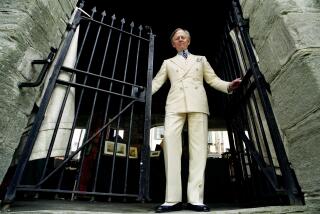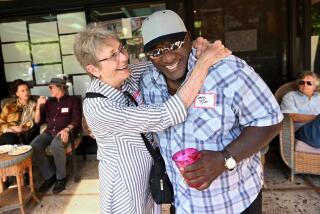Theodore H. White, Author, Dead at 71
Theodore H. White, the owl-faced, Pulitzer Prize-winning journalist and historian who dramatically changed the look of American political reporting with his popular “The Making of the President” books, died late Thursday at New York City’s Lenox Hill Hospital after suffering a stroke. He was 71.
White, according to friends, appeared to be in good health and was involved in writing projects up until last Friday, when he collapsed at his upper East Side Manhattan residence.
“I think he was the greatest journalistic explainer of American politics and American life around,” said his longtime close friend Richard M. Clurman, former chief of correspondents at Time and Life magazines, where White worked for years as a foreign correspondent. “He was a wonderful yarn spinner. He could take the most familiar subject and make it leap into people’s heads.”
A successful reporter of limitless energy for almost half a century, White achieved overnight international stature with his book, “The Making of the President, 1960,” which in 1961 stayed on best-seller lists for almost a year, sold more than four million copies and won him the Pulitzer the following year.
A chronicle of John F. Kennedy’s razor-thin victory over Richard M. Nixon, the book set new standards of reporting in its intimate narrative of the presidential candidates and their respective campaigns for the White House. It became a new genre of political reportage and its “inside stuff” riveted millions.
At work on the book for more than a year before the 1960 election, White, who had total recall and an uncanny ability to synthesize material into fascinating narratives, was able to amass a remarkable assortment of anecdotes. He succeeded in placing the reader beside the candidate during relentless days of campaigning while providing unique glimpses into political strategy sessions.
Years later, White was almost apologetic in describing his new brand of journalism.
‘It’s Overkill’
“It’s overkill,” he explained in a 1969 New York Times interview. “Interview everybody, be everywhere, see everything. The best time to listen to a politician is when he’s on a stump on a street corner in the rain late at night when he’s exhausted. Then he doesn’t lie.”
But as other political reporters picked up on his technique for intimate detail, which became known as the “Teddy White Syndrome,” the author pondered the implications of what he had started.
“It’s appalling what we’ve done to (the candidates),” he told journalist Timothy Crouse in an interview for Crouse’s book on the 1972 presidential campaign press corps, “The Boys on the Bus.” “There’s a conflict here--the absolute need of the public to know versus the candidate’s need for privacy, which is an equivalent and absolute need,” White said. “I don’t know how you resolve it.”
Ever pondering this dilemma, White reflected in a 1978 interview with the Los Angeles Times that “you must never get immersed in the world view of the person you’re covering. On the other hand, how the hell are you going to get to know them if you only cover the public appearances and never sit around chatting?”
Born in Boston
Theodore Harold White was born in modest circumstances in Boston’s Roxbury ghetto on May 6, 1915. White was one of four children. After the death of his father, a lawyer with a small local practice, he sold newspapers in the early days of the Great Depression.
Recalling his life at a downtown Boston streetcar stop, White said: “As the cars pulled up, I’d jump aboard and run through with the papers, then jump out again and onto the next car. It made me agile as hell, but I got bitterer and bitterer.”
His high school grades brought him acceptance from Harvard University but he had to delay further academic life by two years. His family of five was drawing $11 a week on welfare. So at age 16, he taught Hebrew and again sold newspapers to help keep food on the table.
He got to Harvard in 1932, on a newsboy’s scholarship, aspiring to become a historian--but in an ivory tower and not in the hurly-burly world of contemporary journalism.
For reasons that he could never fully explain, White had chosen to immerse himself in Chinese studies under John King Fairbank, a young professor who was to become a national authority on China.
“Fairbank took in this penniless student and made him feel at home, and cared for him and gave him entree to a larger world,” wrote journalist David Halberstam in his 1979 book, “The Powers That Be.”
Then, recounted Halberstam, Fairbank tried to sort out where White would fit in professionally in the world outside Harvard.
Other Possibilities
“He would make a fine scholar,” Halberstam wrote, “but Fairbank thought there were other possibilities, all that energy and curiosity, a skill with words, though perhaps a bit purple. Teddy should be a journalist. For a graduation present he gave him a second-hand typewriter and six letters of introduction for China. It was the making of a journalist.”
Immediately after earning his bachelor’s degree summa cum laude , he caught a bus for Ann Arbor, Mich., where he spent the summer learning colloquial Chinese at the University of Michigan.
Then, on a traveling fellowship, White free-lanced in China for the Boston Globe and Britain’s Manchester Guardian. His on-the-spot reporting of the 1939 bombing of Peking suddenly caused White to abruptly change his goals and pursue a career in journalism, fervently.
Recruited by Time, White covered the war in Asia and ultimately directed the magazine’s China coverage.
By the end of World War II, however, White had had a falling out with Time Editor-in-Chief Henry Luce over his increasingly critical stories about Chiang Kai-shek’s government, and the dispute eventually led to a prohibition of political reporting for the publication.
Never Forgave White
Luce never forgave White for his relentless criticism of Chiang, whose administration was forever in power in the pages of Time, notwithstanding the ascendancy of the Communists.
After the rift, the two men did not talk for a decade. But ultimately, they ended up as good friends after meeting over dinner at a political convention in 1964.
By 1946, White had struck out on his own and co-authored, with another Time correspondent, “Thunder Out of China,” a scathing appraisal of China under Chiang. The book became a best-seller, generated national controversy over Washington’s support of the Nationalist Chinese government and firmly established White’s credentials as a journalist of the first rank.
By 1954, White was laying the groundwork for his formidable “Making of the President” books as chief political correspondent for the now-defunct Colliers. After the magazine folded in 1957, he wrote two novels. One of them, “The View From the 40th Floor,” based on Colliers’ demise, produced (along with film rights) about $85,000, enough to bankroll a project White had been considering for a couple of years.
Idea Rejected
However, three publishers, including his own, rejected White’s idea for a series of books chronicling presidential elections. But Simon Michael Bessie, president of a new publishing firm, Atheneum, took to the proposal and White was off and running on the 1960 campaign trail.
A relative unknown on the political trail, White was relegated to the “zoo plane”--media lingo for the backup campaign plane, which carried those the campaign managers did not value as the nation’s opinion molders.
A head shorter than most of the campaign press corps, the stocky, chain-smoking White was easy to spot, working around the clock and filling dozens of notebooks with the hundreds of minute details that formed his larger campaign mosaic.
“Watch the smiles” (in the crowd), White said of his relentless search for the essence of a political campaign. “How long do they last after the candidate is gone? Watch a factory man shake hands. The better he likes a candidate, the harder he wipes off his hand before he sticks it out. Look at the babies in the crowd. They’re a good omen for a candidate. It means those parents think he can win and want their kids to be able to say they were there when . . .”
From the first paragraph of his landmark 1960 work, readers knew they had begun something special as White focused on New Hampshire’s first-in-the-nation primary:
“It was invisible, as always. They had begun to vote in the villages of New Hampshire at midnight, as they always do, seven and a half hours before (Kennedy) rose. His men had canvassed Hart’s Location in New Hampshire days before, sending his autographed picture to each of the 12 registered voters in the village. They knew that they had five votes certain there, that Nixon had five votes certain--and that two were still undecided. Yet it was worth the effort, for Hart’s Location’s results would be the first flash of news on the wires to greet millions of voters as they opened their morning papers over coffee. But from there on it was unpredictable--invisible.”
Three other “Making of The President” books were to follow, detailing the 1964, 1968 and 1972 campaigns--all major successes.
So successful did the effervescent White become that he himself soon evolved into a celebrity sought out by reporters on the campaign trail.
What were Teddy White’s impressions of some of the politicians he had met over the years?
“Kennedy was the best campaigner,” White told then-Los Angeles Times Associate Editor Robert J. Donovan in a 1972 interview. “But Hubert Humphrey was good. Nelson Rockefeller was a good campaigner. Adlai Stevenson and Kennedy were the most eloquent. They could peel off that stuff like silver ribbons right off the tongue. Adlai was the John the Baptist who trumpeted the way for Kennedy.”
White’s literary critics claimed he was too easy on his political friends. Such criticism caused White to bridle and reply that he had been decidedly critical of Lyndon Johnson and had said--”mildly,” but “clearly”--that Barry Goldwater “was incompetent to be President.”
“If sentiment sometimes blurs his vision, he works hard at being fair and, I think, he almost always succeeds,” observed editor and author Harry S. Ashmore.
In his 1975 analysis of Watergate and the final Nixon days in the White House, “Breach of Faith: The Fall of Richard Nixon,” White concluded that Nixon’s “character was flawed . . . He destroyed the myth that binds America together, and for this he was driven from power.”
“America In Search Of Itself: The Making of the President, 1956-1980,” was White’s coda for modern presidential politics, a vehicle the journalist published in 1982 to sort out his notes and memories.
Clurman said that, when he was stricken, White was still using his old IBM electric typewriter to pound out a new volume in the continuation of his 1978 work, “In Search of History: A Personal Adventure,” a behind-the-scenes story of his career.
White is survived by his wife, Beatrice and two children from a previous marriage.
Times staff writer John Goldman in New York contributed to this article.
More to Read
Sign up for our Book Club newsletter
Get the latest news, events and more from the Los Angeles Times Book Club, and help us get L.A. reading and talking.
You may occasionally receive promotional content from the Los Angeles Times.







